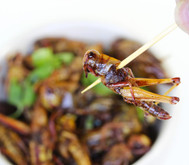Why We Need To Eat Bugs
In a world where the population is increasing towards 8 billion people, we must question where food will come from. In the direction we’re headed, the answer may unfortunately be to increase the number of concentrated animal feeding operations (CAFOs) where cattle, pigs, turkeys, and chickens are kept in confined places and raised for food. This may seem like the natural answer to most people. But most people don’t see the resources lost, the waste involved, and the water contaminated through meat obtained through CAFOs.
Daniella Martin, a blogger for Huffington Post and the host of Girl Meets Bug, gives an accurate picture of this otherwise invisible waste in her book Edible. She describes that per 1 pound of beef there is “4 pounds of manure, 1000 pounds of contaminated water, 200 square feet of space used (2 acres per cow), 10 pounds of feed used, methane (20 times more potent than carbon dioxide), and the carbon released by 1 pound of gasoline” that we don’t see. To even imagine the resources needed and the waste created to feed 8 billion people or more through raising animals in CAFOs is simply scary. So how do we avoid this path? Vegetarianism seems like the logical answer. Although it sounds good, it’s not necessarily realistic. There are many places on earth that aren’t suitable for farming, and these people would starve waiting for food to be shipped out to them once food resources dwindled, not to mentions the high fuel costs involved. Also, animal protein contains complete sets of essential amino acids which are necessary for human functioning. The answer to this global problem could very well lie in our friendly little creature, the insect.
To compare the
waste and resources of animal meat obtained through CAFOs, let’s look at the
numbers for raising insects. To obtain 1
pound of insects, it takes “2 pounds of feed, 1 gallon of water, and 2 cubic
feet of space”
People might
initially turn away at the thought of eating bugs because they’re not a
traditional food source, but preparation and presentation are key. Although they are edible, and can even be
delicious raw, seasoning and cooking insects makes them much more palatable to
those unfamiliar to the idea. Most
people would never eat a slimy, raw, quivering piece of chicken, but once
barbequed and slathered with sauce, everyone’s mouth is watering. Mealworms with chili and garlic fried with
butter are comparable to “little roasted peanuts”
Because we are facing an increasing population, food is a basic need that must be addressed in the most economic and environmentally beneficial way possible. Because insects provide not only the same amount of protein as beef, fish, and chicken, but more vitamins and essential minerals, insects are a smart replacement. They are grown relatively easily in urban areas, do not take up much space or resources, and their waste is biodegradable. They can be prepared like meat and served in dishes where meat is normally featured and can even be delicious. So before you say “Ick,” think about the possibilities for a more nutritious, environmentally-friendly, more efficient future!
References
Bryant, C. W. (2008, August 15). How Entomophagy Works . Retrieved from How Stuff Works: http://people.howstuffworks.com/entomophagy3.htm
Genziuk, S. (2013, January 30). How to Prepare and Eat Mealworms . Retrieved from Ground to ground: http://groundtoground.org/2013/01/30/how-prepare-...
Lallanilla, M. (2013, October 1). 7 Insects You'll Be Eating in the Future. Retrieved from Live Science: http://www.livescience.com/40096-eating-insects-b...
Martin, D. (2014). Edible: An Adventure Into the World of Eating Insects and the Last Great Hope to Save the Planet. New York: Houghton Mifflin Harcourt.

